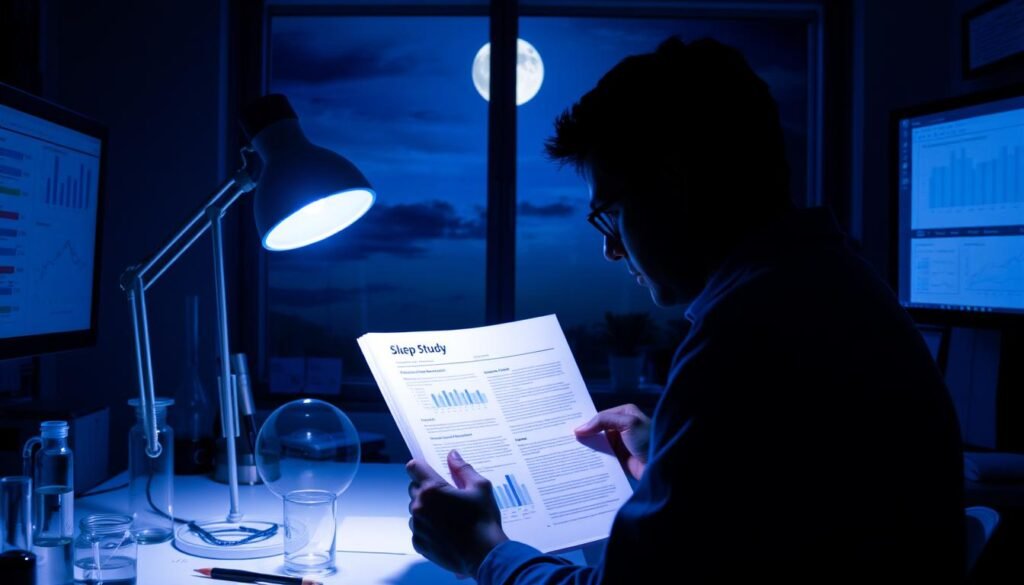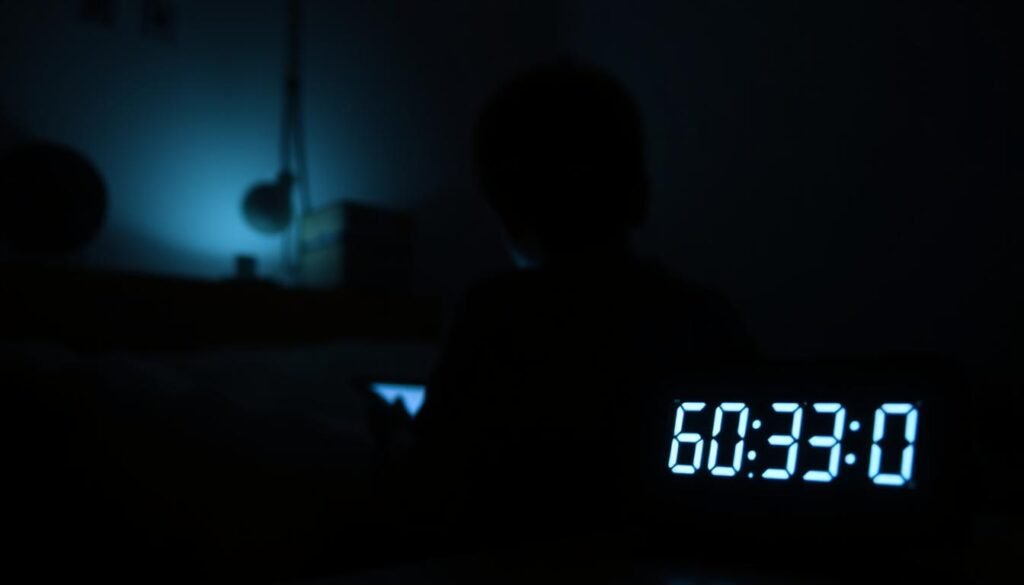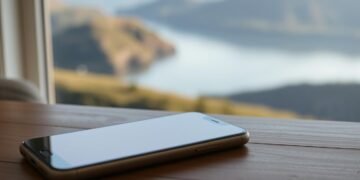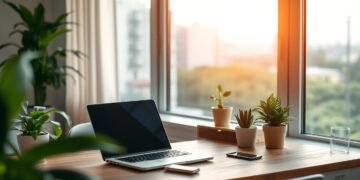Do you ever wonder why you feel tired even after a full night’s rest? The answer might lie in your evening habits. Modern life keeps us glued to devices, but this can disrupt our natural sleep patterns. The good news? A simple, science-backed framework can help.
Enter the 60/30/0 routine. This approach helps align your circadian rhythm and improve sleep quality. By managing screen time before bed, you can wake up feeling refreshed and focused. It’s a practical solution for all ages.
Let’s explore how this method works and why it’s essential for your sleep health. Small changes can make a big difference. Ready to transform your nights and days? Keep reading to learn more.
Key Takeaways
- Excessive screen use can disrupt sleep patterns.
- The 60/30/0 routine is a science-backed solution.
- Improved sleep quality leads to better daytime focus.
- This method aligns your circadian rhythm naturally.
- Practical strategies work for all age groups.
Introduction to Night Screen Rules
Our reliance on devices has transformed how we work, but at what cost to our health? While technology boosts productivity, it often disrupts our ability to rest. This modern paradox leaves many feeling drained, even after hours of sleep.
According to the National Institutes of Health (NIH), the average American spends over two hours on devices before bed. This habit can interfere with our natural sleep cycles, making it harder to fall asleep and stay asleep.
These hidden impacts are often called “sleep stealers.” They include the blue light emitted by devices, which tricks our brains into thinking it’s daytime. Over time, this can lead to chronic sleep issues and affect overall well-being.
The American Academy of Sleep Medicine emphasizes the importance of reducing device use before bed. Their research shows that even small changes can significantly improve sleep quality.
To address this, we’ll explore a three-phase approach to digital detox. This method helps create a healthier relationship with technology, ensuring better rest and improved health. Let’s dive in and discover how to reclaim your sleep.
What is the 60/30/0 Routine?
What if a simple routine could transform your sleep and energy levels? The 60/30/0 method is a structured approach designed to help you wind down effectively and improve your rest. It’s not just about reducing device use; it’s about creating a gradual transition that aligns with your body’s natural rhythms.
Understanding the 60/30/0 Breakdown
This method is divided into three phases, each with specific actions to prepare your mind and body for sleep. Let’s break it down:
60 Minutes Before Bedtime: Start by switching to warm lighting (2200K) and begin your digital wind-down. This helps signal to your brain that it’s time to relax. Activities like reading or listening to calming music can replace device use.
30 Minutes Before Bedtime: Remove all devices from your bedroom and activate blue light filters on any remaining screens. This phase ensures your environment is free from distractions and reduces exposure to sleep-disrupting light.
0 Screens Until Morning: The final phase is a complete tech blackout. This means no phones, tablets, or TVs until you wake up. It allows your brain to fully disconnect and recharge.
Why does this phased approach work? According to a study by the University of Colorado, gradual reduction of device use is more effective than quitting “cold turkey.” It helps your body adjust naturally, making it easier to stick to the routine long-term.
By following the 60/30/0 method, you’re not just improving your sleep—you’re creating a healthier relationship with technology. Small changes can lead to big results, and this routine is a practical way to start.
The Science Behind Blue Light and Sleep
Have you ever considered how light affects your sleep quality? The type of light we’re exposed to, especially in the evening, plays a significant role in our ability to rest. One of the most impactful factors is blue light, which is emitted by devices like phones, tablets, and computers.

Blue light has a wavelength of 400-490nm, making it highly energetic. This energy can interfere with our body’s natural processes, particularly the production of melatonin, the hormone responsible for sleep. Studies show that blue light suppresses melatonin levels 50% more than green light, making it harder to fall asleep.
How Blue Light Affects Your Circadian Rhythm
Our bodies rely on the circadian rhythm to regulate sleep-wake cycles. Specialized cells in our eyes, called retinal ganglion cells, are sensitive to light. Among these, ipRGC photoreceptors play a key role in signaling the brain about light exposure.
When exposed to blue light, these cells send signals that trick the brain into thinking it’s daytime. This delays melatonin production and disrupts the circadian rhythm. Over time, this can lead to chronic sleep issues and even long-term health risks like obesity and diabetes.
Teens are particularly vulnerable to these effects. Research from OHSU reveals that adolescents experience twice the melatonin suppression compared to adults. This makes it even more important to manage light exposure, especially in the evening.
By understanding the science behind blue light, we can take steps to protect our sleep and overall health. Small changes, like reducing device use before bed, can make a big difference in how we feel each day.
Why Night Screen Rules Matter
Have you ever thought about how your evening habits shape your day? The way we unwind before bed can have a profound impact on our overall well-being. Research shows that 62% of Americans sleep with their phones nearby, a habit that can significantly affect sleep quality.
Losing just four hours of rest can reduce natural killer cells by 70%. These cells are crucial for fighting off infections and maintaining health. Poor sleep doesn’t just leave us feeling tired—it can disrupt our brain function, emotional balance, and even our social interactions.
Cognitive Impacts: Disrupted memory consolidation can make it harder to retain information and learn new skills. This can affect both personal and professional growth.
Emotional Consequences: Increased risks of anxiety and depression are linked to poor sleep. A well-rested mind is better equipped to handle stress and maintain emotional stability.
Physical Effects: Cortisol spikes and metabolic changes can lead to weight gain and other health issues. Quality rest is essential for maintaining physical health.
Social Implications: Reduced empathy and patience the next day can strain relationships. Better sleep fosters stronger connections with others.
Productivity Costs: Sleep loss costs the U.S. economy $411 billion annually. Prioritizing rest can boost both personal and national productivity.
By understanding why these habits matter, we can take steps to improve our sleep and overall quality of life. Small changes in our evening routine can lead to big improvements in how we feel and function each day.
How to Implement the 60/30/0 Routine
Ready to take control of your evenings and improve your sleep? The 60/30/0 routine is a simple yet effective way to transition from a busy day to a restful night. By following this structured approach, you can reduce distractions and create a calming environment that supports better rest.
Step-by-Step Guide to the 60/30/0 Routine
Phase 1: Dinner-to-60 Minutes Transition
Start by switching to warm lighting and begin your digital wind-down. Replace device use with calming activities like reading or listening to music. Tools like the Twilight app for Android or f.lux for desktop can help reduce blue light exposure during this hour.
Phase 2: Family Device Check-In Station
Set up a designated spot for all devices 30 minutes before bedtime. This ensures your bedroom remains a distraction-free zone. Consider using JINS Screen glasses, which reduce blue light by 35-65%, to further protect your eyes.
Phase 3: Analog Activity Alternatives
Replace screen time with analog activities like journaling, stretching, or light meditation. These practices help signal to your brain that it’s time to rest. Avoid using any devices during this phase to maximize its effectiveness.
Troubleshooting Common Resistance Points
If you’re tech-dependent, start with a gradual adaptation schedule. For example, reduce device use by 15 minutes each week until you reach the full 60/30/0 routine. Consistency is key to making this habit stick.
By following these steps, you can create a healthier relationship with technology and improve your sleep quality. Small changes lead to big results, and this routine is a practical way to start.
Tips for Reducing Screen Time Before Bed
Are you struggling to disconnect from your devices in the evening? Reducing screen time before bed can significantly improve your sleep quality and overall well-being. Let’s explore practical strategies to help you wind down effectively.
Practical Strategies for Cutting Down on Screen Use
Start with the 20-20-20 rule: Every 20 minutes, look at something 20 feet away for 20 seconds. This reduces eye strain and helps you disconnect gradually. Pair this with red night lights (1000K), which maintain melatonin levels and create a calming atmosphere.
Consider setting up a family contract for tech curfews. This encourages accountability and creates a shared commitment to reducing device use. You can also try a “Screen Sabbath” weekend challenge, where everyone in the household takes a break from screens for a day or two.
App-based accountability systems can help track and limit screen time. Tools like Forest or Moment remind you to stay focused and reduce distractions. Replace device use with analog activities like reading, journaling, or light stretching to signal to your brain that it’s time to rest.
Finally, design your environment to support your goals. Place charging stations outside bedrooms to eliminate the temptation of late-night scrolling. Small changes like these can make a big difference in reducing smartphone use and improving your sleep quality.
The Role of Blue Light Filters and Glasses
Ever wondered how to protect your eyes and sleep from modern tech? Devices emit blue light, which can disrupt our natural rhythms. Fortunately, tools like filters and glasses can help mitigate these effects. Let’s explore how they work and why they’re essential for your well-being.
How Blue Light Filters and Glasses Can Help
Both software and hardware solutions are available to reduce blue light exposure. Software options like iOS Night Shift and Android Night Light adjust your device’s color temperature. These apps shift the display to warmer tones, reducing eye strain and promoting relaxation.
For added protection, consider blue light-blocking glasses. Brands like Gunnar offer lenses that block up to 65% of harmful light. These glasses are available in prescription and non-prescription options, making them accessible for everyone.
Here’s a quick comparison of popular solutions:
- iOS Night Shift: Automatically adjusts the display based on time of day.
- Android Night Light: Similar to iOS but with customizable intensity settings.
- Gunnar Glasses: Block 65% of blue light and reduce glare.
Combining these tools can enhance their effectiveness. For example, using a filter mode on your device while wearing glasses provides double protection. This approach is especially useful for those who spend long hours in front of screens.
By integrating these solutions into your routine, you can safeguard your sleep and eye health. Small changes, like activating a filter mode or wearing glasses, can make a big difference in how you feel each day.
Creating a Sleep-Friendly Environment
Ever thought about how your surroundings affect your sleep? Your bedroom plays a crucial role in ensuring you get the rest you need. By optimizing your space, you can create an environment that supports deep, restorative sleep.
Start with the basics. The ideal sleep temperature is between 60-67°F. This range helps your body naturally cool down, signaling it’s time to rest. Pair this with the right lighting. Soraa Healthy bulbs, which use violet LEDs, mimic natural light and reduce harmful light exposure.
How to Optimize Your Bedroom for Better Sleep
Begin with a lighting audit. Replace harsh bulbs with warm, dimmable options. This reduces strain on your eyes and creates a calming atmosphere. Consider soundscaping or white noise machines to block out disruptive noises. These tools can help you fall asleep faster and stay asleep longer.
Next, focus on tactile elements. Choose soft, breathable bedding and pillows that support your sleep posture. Integrate aromatherapy with essential oils like lavender or chamomile to promote relaxation. Finally, apply Feng Shui principles to create tech-free zones, keeping devices out of your sleep space.
By making these small changes, you can transform your bedroom into a sanctuary for rest. A well-designed environment not only improves sleep quality but also enhances your overall well-being.
The Impact of Night Screen Rules on Children
Children’s sleep habits are more critical than ever in today’s digital age. With 73% of kids having electronic devices in their bedrooms, it’s no surprise that their rest is often disrupted. Pre-teens need 9-12 hours of sleep nightly, but the presence of devices can make this goal challenging to achieve.

Why is this such a pressing issue? Kids are particularly vulnerable to the effects of blue light and overstimulation. Their developing brains and bodies rely on quality sleep for growth, learning, and emotional well-being. When devices affect sleep, it can lead to a cascade of negative outcomes.
Why Managing Devices is Essential for Kids
Children’s developmental stages make them more susceptible to sleep disruptions. Their brains are still forming, and poor rest can impact memory, attention, and even behavior. Studies show that kids who use devices before bed often struggle with falling asleep and staying asleep.
School performance is another area affected by poor sleep. Kids who don’t get enough rest may have trouble focusing in class, leading to lower grades. Over time, this can create a cycle of stress and fatigue that’s hard to break.
Practical Strategies for Families
Creating a family media agreement can help set clear boundaries. This template can outline when and where devices are allowed, ensuring consistency across the household. Age-adjusted screen time limits are also crucial, as younger children need stricter guidelines than teens.
Pediatrician-approved tech rewards can motivate kids to follow these rules. For example, earning extra playtime for adhering to device-free hours before bed can make the transition easier. Small changes like these can lead to big improvements in sleep quality and overall well-being.
Common Challenges and How to Overcome Them
Implementing changes to your evening routine can feel challenging, but with the right strategies, it’s achievable. Many people struggle to stick to new habits, especially when it comes to reducing screen time before bed. Studies show a 68% relapse rate without proper support systems in place. Let’s explore how to address these obstacles effectively.
Adapting to Different Lifestyles
Not everyone’s schedule fits a standard routine. Night owls, for example, may need gradual adjustments to their wind-down process. Shift workers face unique challenges, as their devices often play a crucial role in their daily lives. For these individuals, tailored strategies like flexible timing or specialized lighting can make a big difference.
Accommodating Medical Needs
Some people rely on devices for health monitoring or communication. In these cases, it’s important to find a balance. Using blue light filters or setting specific usage times can help minimize disruptions to sleep while still meeting medical needs.
Handling Social Pressures
Social expectations can make it hard to disconnect. Preparing coping scripts, like politely declining late-night messages, can help you stay committed to your screen time goals. Remember, prioritizing your health is not selfish—it’s essential.
Tracking Your Progress
Consistency is key to forming new habits. Use progress tracking methodologies, like journaling or apps, to monitor your success. Celebrate small wins to stay motivated and build momentum over time.
By addressing these challenges head-on, you can create a sustainable routine that supports better sleep and overall well-being. Small, thoughtful changes can lead to lasting improvements in your daily life.
Conclusion
Transforming your evening habits can lead to lasting improvements in your daily life. Start with a 30-day implementation challenge to gradually reduce distractions and create a calming routine. Community support resources, like online forums or local groups, can provide encouragement and accountability.
Track your progress using validation metrics, such as sleep quality logs or app-based reminders. This helps you stay consistent and motivated. Over time, these small changes can lead to long-term habit maintenance, ensuring you continue to prioritize your health.
Integrate holistic practices, like mindfulness or light stretching, to enhance your overall well-being. By focusing on better sleep and reducing screen time, you’ll wake up feeling refreshed and ready to tackle the day. Let’s take these steps together and create a healthier, more balanced lifestyle.
FAQ
What is the 60/30/0 routine?
The 60/30/0 routine is a simple method to reduce light exposure from devices before bed. It involves no use of electronic devices 60 minutes before sleep, dimming screens 30 minutes prior, and avoiding all devices in the bedroom.
How does blue light affect sleep?
Blue light from devices can disrupt your circadian rhythm by suppressing melatonin production. This makes it harder to fall asleep and reduces sleep quality.
Why is this routine important for kids?
Children are more sensitive to light exposure, which can interfere with their sleep-wake cycle. Implementing these rules helps them develop healthier sleep habits early on.
Can blue light filters or glasses help?
Yes, blue light filters on devices or special glasses can reduce the impact of blue light. However, it’s still best to limit device use before bed for optimal results.
What are some tips to reduce screen time before bed?
Try replacing device use with calming activities like reading, journaling, or meditation. Setting a consistent bedtime routine also helps signal your brain it’s time to wind down.
How can I create a sleep-friendly environment?
Keep your bedroom dark, cool, and quiet. Remove devices and use blackout curtains or an eye mask to minimize light exposure for better sleep quality.
What if I struggle to stick to the routine?
Start small by reducing device use in 10-minute increments. Gradually increase the time until you reach the 60/30/0 goal. Consistency is key to forming new habits.




